Diego Velazquez Las Meninas
I. Las Meninas :
A Perfect Snapshot
In the Prado Museum in Madrid, Spain, one encounters the magisterial opus of Velázquez, “Las Meninas”, a painting brimming with genuine authenticity. It captures a slice of everyday life in the Spanish palace, showcasing recognizable figures that anyone at the court would know well. Diego Velazquez’s “Las Meninas” effortlessly paints a vivid picture of a normal day at the Spanish court, filling the entire canvas with this scene.
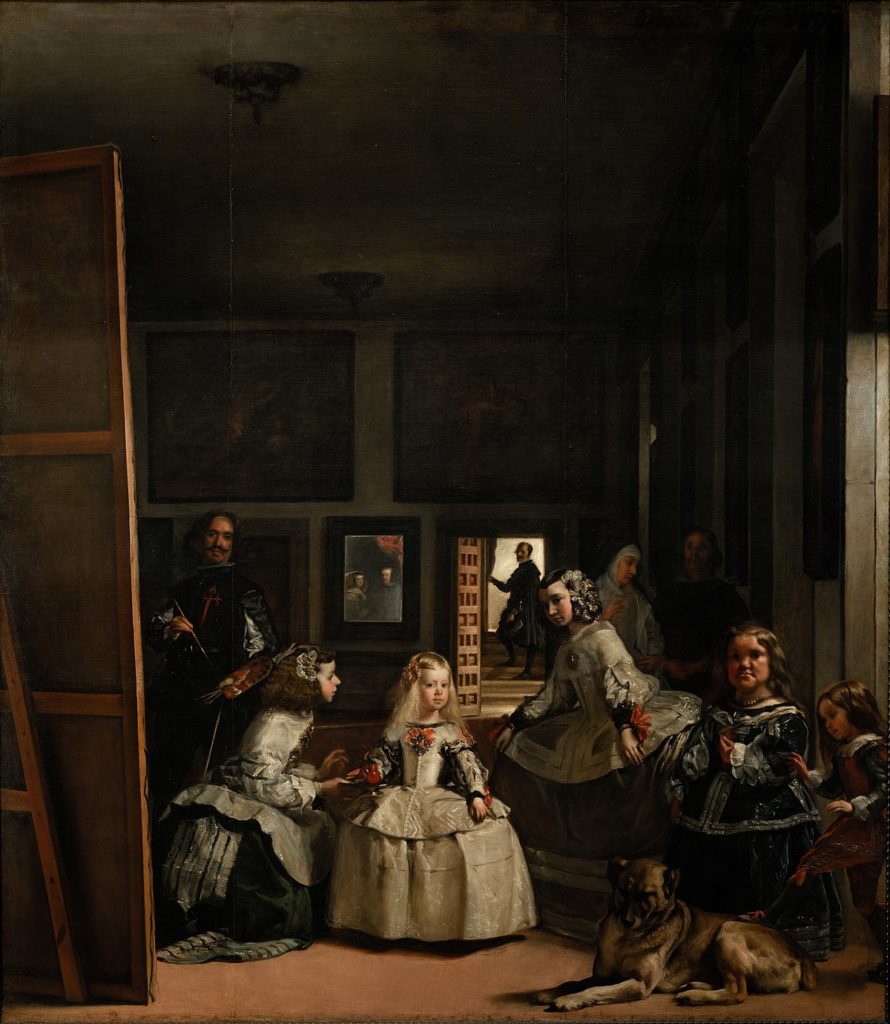
On the left end of the canvas stands the tall and elegantly mustached artist before a canvas, a piece that dwarfs his presence. Velázquez, completely engrossed in his work, suddenly appears astonished as he notices the onlooker observing him. His expression conveys a profound sense of astonishment upon realizing the presence of an observer within this intimate artistic space.
—
In the center of this composition, we find that Princess Margarita, an embodiment of regal poise, tands with a subtle aloofness, dressed in an endearing outfit while fulfilling her role as a model, visibly fatigued from the task. At her side stands the maid Maria Agustina Sarmiento, diligently attempting to engage the young princess in conversation, seemingly persuading her to maintain her pose a while longer. To add a touch of cheerfulness, a cherished canine companion graces the scene. Additionally, the jovial presence of the plump dwarf lady, Maria Barbola, and the playful young courtier, Nicolás Pertusato, urther enlivens the setting.
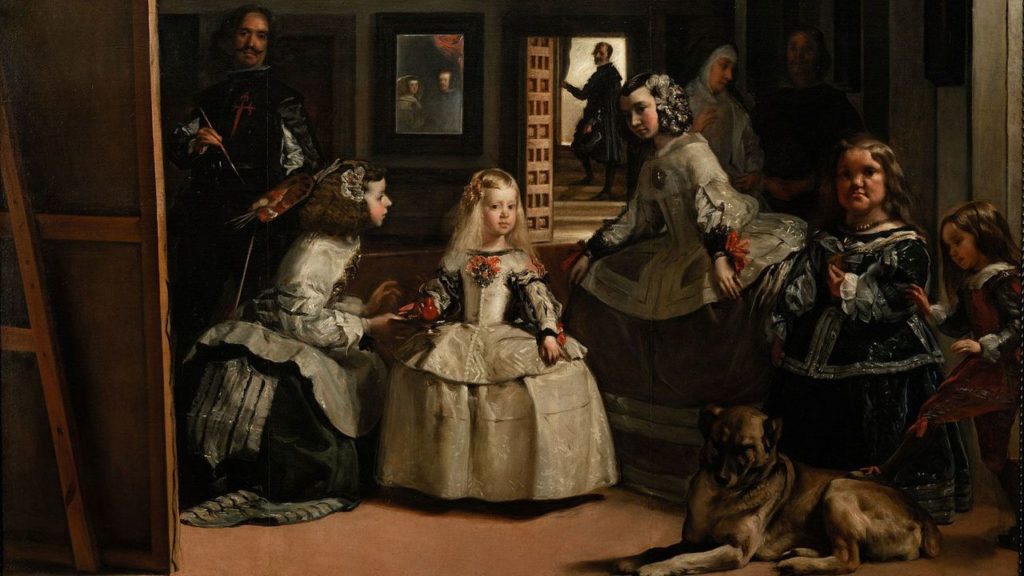
However, the depicted scene in “Las Meninas” coincides with the moment when King Felipe IV and the Queen happen to enter the room, seemingly curious about what is happening inside. Nevertheless, Maria, the maid, remains unaware of the arrival of the King and Queen as she continues to comfort Princess Margarita. Meanwhile, another maid, Isabel de Velasco, is taken aback and quickly rises, holding the edge of her skirt with both hands, bowing forward, and bending her knees slightly to greet the royal figures courteously.
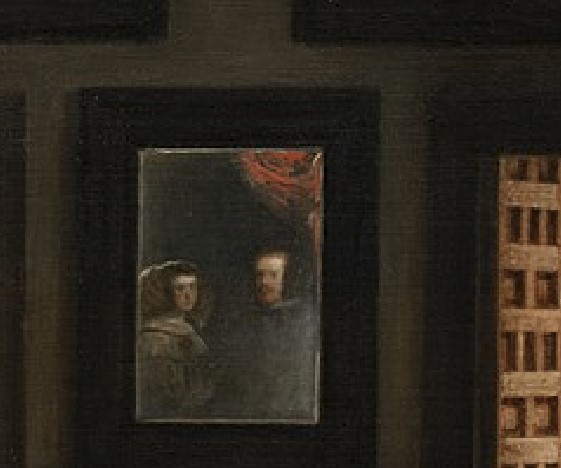
In the shadows behind Isabel de Velasco, the governess Marcela de Ulloa is engaged in conversation with another servant, still unaware of the unexpected situation. Near the open door in the background, the knight Don José Nieto Velázquez appears to be stepping out of the room. One foot is poised on the stairs, and he turns his body to gaze towards the entrance. It is a remarkably skillful and ingenious artwork in the sense that all the movements and expressions of these characters are incredibly natural and dynamic akin to a candid snapshot.
—
In the 17th century, the era of Velázquez’s activity, the prevailing artistic movement in Europe, including Spain, was the dynamic Baroque style. In contrast to the serene and static worlds pursued in the works of artists like da Vinci or Raphael, Baroque art aimed to capture the fleeting moments of reality through bold techniques, depicting the constantly changing and dramatic nature of existence. Surprisingly, “Las Meninas” refrains from opulent poses or theatrical expressions. Nonetheless, it rightfully earns its place within the Baroque tradition, primarily attributed to its masterful composition and adept utilization of light and shadow to seize a fleeting moment amidst the continuum of everyday life.
II. The Composition
1. Vertical & Horizontal
Firstly, the overall composition of “Las Meninas” is characterized by a harmonious interplay of vertical and horizontal elements. These visual cues starts from the window and pillar on the right, traverse through the open door in the foreground, encompass the mirror hanging on the adjacent wall, envelope the two large tapestries and the ceiling above, and ultimately culminate at the canvas located at the left extremity of the scene.
2. A Pyramid-like Structure
Secondly, the deliberate arrangement of the two maids subtly tilting their bodies, around which the main characters in “The Maids of Honor” are gathered and the astute organization wherein the princess stands out brightly at the center, while others assume varying degrees of shadow according to their roles, serves to craft a pyramidal structure. This reflects intentional design rather than mere happenstance.
3. Using a Mirror
Moreover, the artistry lies in the technique of incorporating the portraits of the key figures surrounding Princess Margarita into a single scene. Contrary to the title of the painting, ‘Las Meninas’, the central character is the young princess herself. On the other hand, all of the other individuals hold significant role in the young princess’s life. That being said, in the typical portrait setting, it is unusual to encapsulate both royal dignitaries and jesters, playmates, or maids within a singular composition. So as to overcome the dilemma, the artist resorted to a clever technique involving mirrors.
—
In contrast to Van Eyck’s creation of a miniature universe within the convex mirror of the “Arnolfini Portrait,” Diego Velázquez employed the mirror in ‘Las Meninas’ as a tool to include what could not be directly placed on the canvas. Whereas Van Eyck reproduced a miniature world on the convex mirror within “Arnolfini Portrait”, the mirror in Diego Velázquez’s ‘Las Meninas’ served as a device to assist in including what could not be directly placed on the canvas. The style of adopting a mirror in this manner was by no means new.
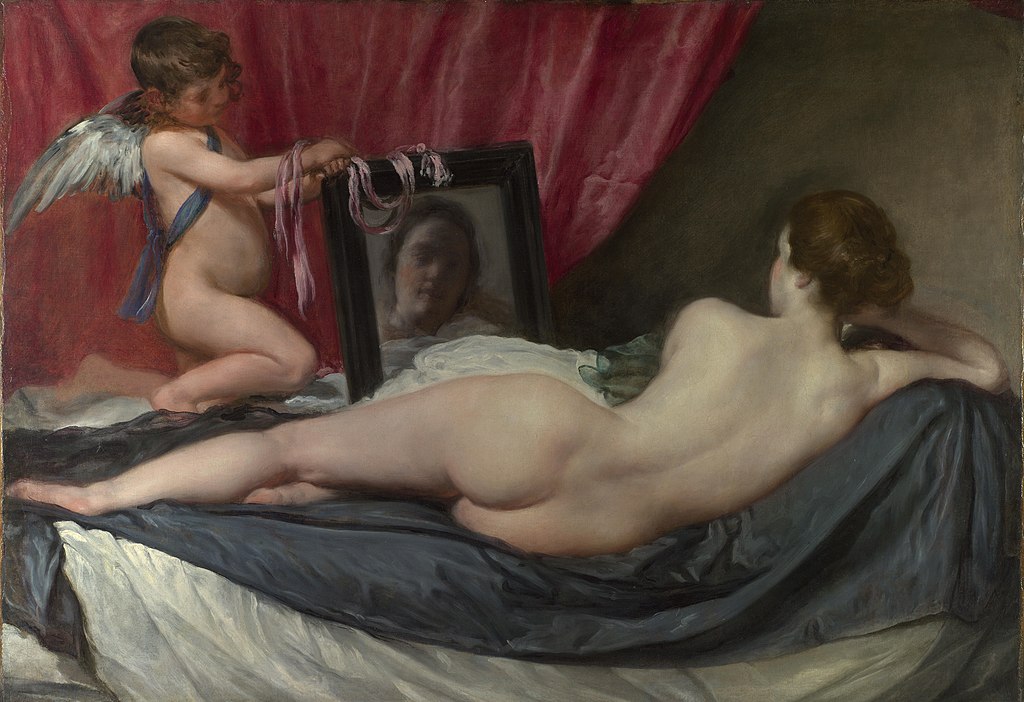
In the exquisite artwork “Venus at her Mirror,” created by Diego Velázquez before “Las Meninas,” we witness Venus reclining sensually on a bed, her graceful curves and rosy hue captivating the eye. The goddess of beauty deliberately veils her visage as she turns away, maintaining an air of mystery. Yet, Velázquez ingeniously devised a solution by placing Cupid, bearing a mirror, at Venus’s side. This mirror adeptly reflects her concealed countenance. Akin to “Las Meninas”, the use of the mirror serves to unveil that which would otherwise remain concealed, granting us a glimpse of Venus’s hidden allure.
III. Impressionist Brushwork
In the Velázquez’s work, the painter’s brushstrokes are distinctly visible and remain vividly etched upon the canvas, allowing viewers to discern the direction and technique used. Upon close examination, the brush in Velázquez’s hand in “Las Meninas” is a roughly sketched single stroke, de facto a mere line. Similarly, the lace embellishment on the hand holding the palette appears as if randomly splashed with paint. This technique creates ambiguity upon close scrutiny, blurring the distinction between the brush and lace.

However, when viewed from a slight distance, the scratched line appears like a brush ready to move at any moment. At the same time, the playfully smeared paint marks appear as delicate lace decorations. Even Princess Margarita’s light golden hair, akin to a faint golden haze, is nothing more than a thin layer of paint.
—
In spite of that, precisely here is where the secret and essence of “Las Meninas” lie. In the painting, each line and surface, seemingly rendered with careless strokes, is accompanied by a masterful use of shading techniques. In this regard, Velázquez demonstrated a departure from the style of 15th-century Flemish painters who meticulously insisted on reproducing distant objects as if holding them in their own hands for observation.
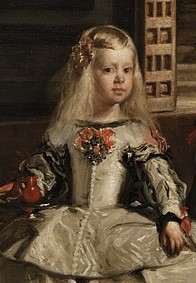
The painting technique of Velázquez, its precise color tones and liberated brushwork, stands in stark contrast to the classical method, which meticulously outlines forms before carefully filling them with color. Instead, the technique aligns more with the methods favored by later Romantic and Impressionist painters like Delacroix and the Impressionists. Notably, in Velázquez’s masterpiece “Las Meninas,” his brushwork presages the Impressionist style that would not fully emerge until nearly two centuries later.
IV. Diego Velázquez & Cross Insignia
The era in which Diego Velázquez (1599-1660) flourished is generally categorized as the Baroque period in art history, and his primary stage was the Spanish court. Consequently, numerous works in his oeuvre, encompassing formal portraits and historical compositions, were commissioned by and created for the Spanish court. Thus, he was essentially employed by the court. In “Las Meninas,” Velázquez proudly displays the cross insignia of the Order of Santiago on his chest, emblematic of his extensive tenure in the service of the court.
—
It is of significance to acknowledge that Velázquez became a member of the Order of Santiago in 1658, a full two years subsequent to the finalization of “Las Meninas.” Consequently, it is reasonable to surmise that the painting did not initially incorporate the cross insignia on Velázquez’s chest. An anecdote surrounding “Las Meninas” posits that upon the inaugural viewing of the completed masterpiece by King Philip IV, the absence of this emblem on Velázquez’s chest caught the monarch’s attention, leading to his comment, “You forgot something important.” Reportedly, the king proceeded to take up a brush himself, adding the cross insignia.
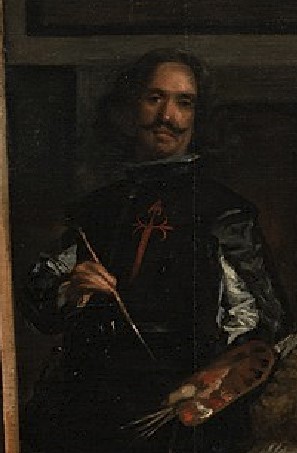
However, at that time, Velázquez had not yet joined the Order of Santiago, making this anecdote a later creation. If closely observed, one cannot help but acknowledge that the cross insignia itself is an embodiment of Velázquez’s distinctive brushwork—rough yet precise, not a spontaneous brushstroke made by the king. Indeed, it was only added two years subsequent to the final brushstroke of “Las Meninas,” coinciding with Velázquez’s formal induction into the Order. Interestingly, the quality of the painting is so exceptional that it appears as though it was originally painted that way.